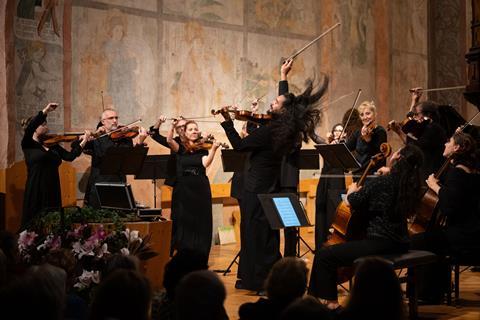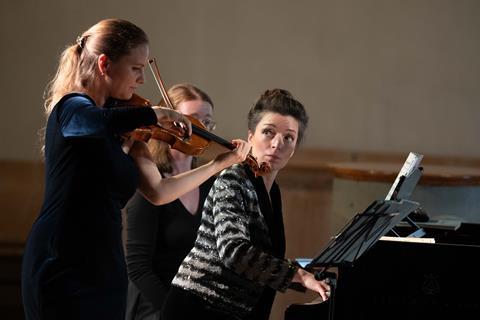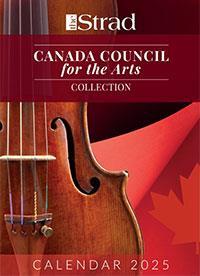The Gstaad Menuhin Festival presented more than 60 concerts over six weeks in the Swiss Alps during the summer of 2024. Laurence Vittes sampled some of the best of its strings programming

Discover more Featured Stories like this in The Strad Playing Hub.
Read more premium content for subscribers here
The 68th Gstaad Menuhin Festival and Academy, featuring more than 60 concerts, took place from 12 July to 31 August, forming the central part of an overarching three-year theme focusing on change and transformation. The symphonic, operatic and choral events played out in the Festival Tent in Gstaad, but the heart of the festival remains its chamber music strand, held in churches including those of Gstaad, Saanen and Rougemont.
The concerts I heard in mid-July were both at Saanen Church, and were attended by large, enthusiastic audiences. Many people had arrived on chartered buses from neighbouring hamlets and villages and from as far away as Bern and Lausanne. The audiences, who tended towards an older and well-heeled demographic, loved every beat of every bar each night.
Both concerts featured violinists. Nemanja Radulović and his Double Sens ensemble played flamboyant arrangements of Beethoven’s ‘Kreutzer’ Sonata and Rimsky-Korsakov’s Sheherazade followed by twenty minutes of encores from the Serbian virtuoso’s Roots album. German violinist Julia Fischer played and conducted Beethoven’s Violin Concerto and both his romances (the second as an encore) with the Camerata Salzburg, whom she also led in Richard Strauss’s Metamorphosen.
Fischer moved like an empress through the Beethoven Concerto, cool and serene with flashes of radiant warmth, flourishing in Kreisler’s cadenzas. In the small church, the Salzburg Camerata followed her with catlike grace and provided ready power in the timpani and brass when needed. The woodwinds were glorious. Hearing the music up close in such an intimate space brought you inside the orchestra at times, seemingly making Beethoven new again.
Fischer had only once previously played the Beethoven without a conductor. ‘I was supposed to perform it with Neville Marriner and the Academy of St Martin in the Fields in Vienna in 2016,’ she told me, ‘but he died on the day of our rehearsal. When I was told that Neville had just passed away, and we were thinking of what we ought to do, we decided that he would have wanted us to play.’

She told me that she was playing the Beethoven without a conductor in Gstaad because artistic director Christoph Müller, who has made a career of creating magic at the festival, had asked her to do it that way. ‘In this space here with the small orchestra, the musicians can be focused and much more concentrated without the distraction of a conductor,’ he told me in a later conversation.
‘I do enjoy having a conductor when I play the Beethoven,’ Fischer admitted, ‘but the church in Saanen is small, so you only need a small orchestra. And honestly, if you only have four cellos and six first and six second violins, you really don’t need a conductor.’
A couple of days previously, as part of her artist-in-residence duties, Fischer had played an intriguing recital of Beethoven, Khachaturian, Ysaÿe and Franck with Yulianna Avdeeva; and in a remarkable feat on the following Saturday, she switched to playing the piano for Dvořák’s Piano Quintet in A major op.81, having beforehand led a performance of Smetana’s First String Quartet, alongside Alexander Sitkovetsky.
Radulović’s exhilarating ride with Beethoven and Rimsky-Korsakov the night before had delivered a vision of what classical music concerts could be like if they were choreographed by Walt Disney and played by Jascha Heifetz with a little industrial remix on the side. In his two technicoloured arrangements and a dazzling swirl of encores, Radulović was apt to jump into the air or whirl on his heels as the music moved him. Double Sens is an ensemble of virtuosos, attuned to his every shift of mood and tempo, and who looked like they were ready to dance too. I was impressed by the searing emotional authenticity of his Beethoven and the fun he had with Sheherazade. He was not responsible, of course, for the claps of thunder and flashes of lightning outside the church that threatened to interrupt the ‘Kreutzer’ at the most dramatic point of the last movement, when just for a moment it seemed as if Beethoven was shaking his fist and helping Radulović bring the music to its final triumphant close. On the other hand, how much more authentically Beethovenian can you get?
Nemanja Radulović was apt to jump into the air or whirl on his heels as the music moved him
While Radulović’s own arrangement of the ‘Kreutzer’ left the original more or less intact, Aleksandar Sedlar’s vivid rewrite of Sheherazade shaved off around 20 minutes, leaving only the third movement whole and setting the stage for the encores, which kicked off with an Aleksandar Šišić medley that had Radulović high-fiving his orchestra and stomping his booted foot in a gypsy romp. Among the other encores were a little sad–happy musette called Indifférence and Jonče Hristovski’s Macedonian Girl – which had the whole church clapping. They also included ‘Méditation’ from Thaïs. And as the last encore – Yvan Cassar’s arrangement of Monti’s Csárdás – was ending, the thunder reappeared but was drowned out by the audience’s roars of applause.
Müller pointed out that he had programmed Radulović and Fischer in order to represent differing visions of a classical music concert. He had invited Radulović to play his arrangements as part of the festival’s ongoing effort to win new audiences with concert formats that are as much about entertainment as they are about serious programming – which Müller takes to mean ‘serious music only: Schubert or Shostakovich’. He told me: ‘This is why we have Radulović. It’s a good example in that he is a brilliant entertainer, but also plays the violin incredibly.’ So much so, Müller added, that ‘he’s genuinely outstanding in a real, classical music way’.
Behind the scenes, the biggest story of the festival was that Müller, who has shaped the festival we know today, will be stepping down after his 24th season, concluding his tenure at the end of the 2025 festival, after which he’ll be succeeded by the violinist Daniel Hope. Müller told me: ‘A moment came when I felt that it was important for the institution that someone else bring in new ideas and visions. I thought that my work here was done.’ Hope will officially start with the festival’s 70th edition in 2026, which will honour its founder, Yehudi Menuhin.
Read: My experience: Willard Carter at the Gstaad Menuhin Festival and Academy
Read: Postcard from Switzerland: Verbier Festival
Discover more Featured Stories like this in The Strad Playing Hub.
Read more premium content for subscribers here
The number one source for playing and teaching books, guides, CDs, calendars and back issues of the magazine.
In The Best of Technique you’ll discover the top playing tips of the world’s leading string players and teachers. It’s packed full of exercises for students, plus examples from the standard repertoire to show you how to integrate the technique into your playing.
The Strad’s Masterclass series brings together the finest string players with some of the greatest string works ever written. Always one of our most popular sections, Masterclass has been an invaluable aid to aspiring soloists, chamber musicians and string teachers since the 1990s.
The Canada Council of the Arts’ Musical Instrument Bank is 40 years old in 2025. This year’s calendar celebrates some its treasures, including four instruments by Antonio Stradivari and priceless works by Montagnana, Gagliano, Pressenda and David Tecchler.


































![[1st prize] Poiesis Quartet in round 3 (2)](https://dnan0fzjxntrj.cloudfront.net/Pictures/100x67/1/9/5/41195_1stprizepoiesisquartetinround32_547631.jpg)










No comments yet